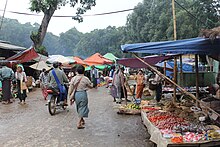
Economic edit
Economic geography examines relationships between human economic systems, states, and other factors, and the biophysical environment.
- Subfields include Marketing geography and Transportation geography
Speculations for the cause of Hurricane Katrina edit
Many commentators immediately began to discuss global warming in the wake of the hurricane, with increased debate that global warming significantly increases the number and intensity of extreme weather events. There have even been claims that the United Nations (UN) scientists responsible for the UN Global Warming report have categorically denied Global Warming had any impact on hurricane strength or frequency in the past fifty years, but these reports are usually based on opinion, with no peer-reviewed scientific evidence to back up the claims[1].
Even more fanciful speculations came from a few who held outspoken fundamentalist religious views, asserting the hurricane was divine retribution for any of a number of provocations, including politically-charged issues such as the War in Iraq, U.S. pressure for the Israeli withdrawal from Gaza, and domestic issues such as abortion and tolerance for homosexuality.
Parameters edit
The different dimensions, or plot axes, of a niche represent different biotic and abiotic variables. These factors may include descriptions of the organism's life history, habitat, trophic position (place in the food chain), and geographic range. According to the competitive exclusion principle, no two species can occupy the same niche in the same environment for a long time. The parameters of a realized niche are described by the realized niche width of that species. Some plants and animals, called specialists, need specific habitats and surroundings to survive, such as the spotted owl, who lives specifically in forests of old growth. Other plants and animals, called generalists, are not as particular and can survive in a range of conditions, such as the dandelion.[2]
In 2007 the National Science Foundation prioritized its funding to complete research on “coupled natural and human systems,” under the title, [1]Biocomplexity in the Environment. This was later broken up into more specific subgroups, such as
- Dynamics of Coupled Natural and Human Systems
- Materials Use: Science, Engineering, and Society (Deadline Date: February 7, 2007)
- Environmental Genomics
External links edit
- CHANS-Net is an international network for researchers studying or people interested in the topic of Coupled Human and Natural Systems. The organization facilitates communication and collaboration.
- Biocomplexity in the Environment, a 2006 priority area of the National Science Foundation.
This is a user sandbox of IstGebongt. You can use it for testing or practicing edits. This is not the sandbox where you should draft your assigned article for a dashboard.wikiedu.org course. To find the right sandbox for your assignment, visit your Dashboard course page and follow the Sandbox Draft link for your assigned article in the My Articles section. |
So begins a new chapter in my saga as a "non-traditional" student. What is traditional, anyway? Out with the old, in with the new, I say.
- ^ "United Nations Official Admits the Purpose of the Global Warming Hoax is to Destroy Capitalism". Lubbock Avalanche-Journal. 02/27/2015.
{{cite web}}: Check date values in:|date=(help) - ^ Moseley, William; Perramond, Eric; Hapke, Holly; Laris, Paul (2014). An Introduction to Human-Environment Geography. West Sussex, UK: Wiley Blackwell. p. 81. ISBN 978-1-4051-8932-3.